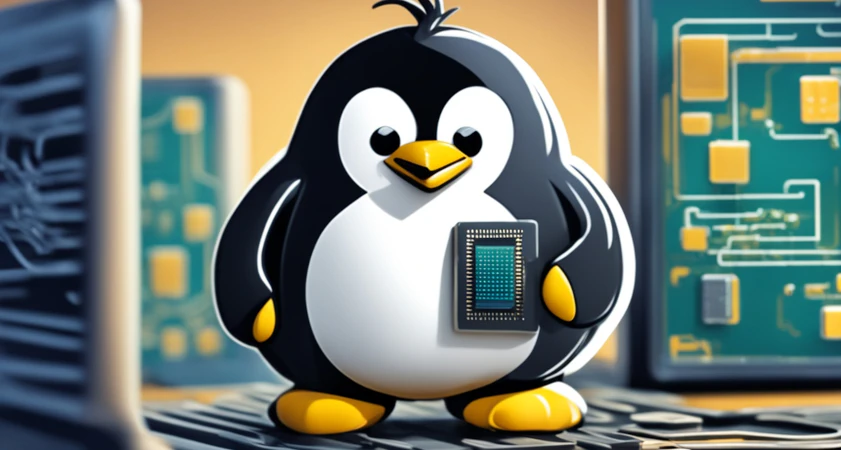Embedded Linux distros are revolutionizing the world of embedded systems and IoT devices. As a developer, you need to choose the right operating system to power your projects efficiently. Embedded Linux operating systems offer a perfect blend of flexibility, performance, and resource optimization, making them ideal for a wide range of applications. Whether you’re working on smart home devices, industrial automation, or cutting-edge robotics, selecting the best Linux distro for development is crucial to your success.
In this article, you’ll discover the top embedded Linux distros that cater to developers’ needs. We’ll explore the rise of embedded Linux systems in IoT and edge computing, highlighting their growing importance. You’ll learn about popular embedded Linux distributions and the key features to look for when choosing an embedded Linux OS. By the end, you’ll have a clear understanding of which distro best suits your development requirements, enabling you to create robust and efficient embedded solutions.
The Rise of Embedded Linux in IoT and Edge Computing
Growth of IoT Devices
The Internet of Things (IoT) has transformed the way you interact with everyday objects. IoT refers to devices embedded with sensors, software, and communication capabilities that can exchange data and interact with each other, often without human intervention . This technology aims to make your life and businesses more efficient, convenient, and interconnected.
As IoT continues to grow, embedded Linux has emerged as a dominant force in the market, underpinning a multitude of devices and applications . Its prevalence is grounded in several key factors:
- Versatility: Linux’s inherent flexibility makes it suitable for a wide range of embedded devices, from lightweight sensors to complex industrial controllers.
- Cost-Effectiveness: Being open-source, it eliminates the need for expensive licensing fees, reducing the overall cost of device development and ownership.
- Reliability: Linux has a proven track record of stability and uptime in critical applications, which is vital for IoT devices that often operate unattended for extended periods.
- Community Support: The Linux kernel and many associated projects benefit from robust community support, ensuring continuous improvement and a rich pool of shared knowledge .
Advantages of Linux for Embedded Systems
Linux offers several advantages that make it an ideal choice for embedded systems and IoT devices:
- Customizability: You can tailor Linux to meet the specific needs of a particular device or application, which is crucial for IoT technology that often requires unique configurations .
- Scalability: Linux can run on a wide variety of hardware, from small, low-resource devices to large computers, making it highly adaptable to different IoT scenarios .
- Security: Linux provides robust security features, including secure boot, access controls, and the ability to incorporate the latest security patches, which are essential for protecting IoT devices from cyber threats .
- Networking Capabilities: Linux supports a vast array of networking protocols natively, which is critical for IoT devices that need to communicate across different networks and protocols .
- Long-Term Support: Many Linux distributions offer long-term support versions, ensuring that devices can remain secure and functional with consistent updates over their lifespan .

Common Use Cases
Embedded Linux has made significant inroads across various sectors, demonstrating its versatility and robustness through a multitude of real-world applications . Here are some common use cases:
- Smart Home Technology: Devices like smart thermostats and lighting systems utilize Embedded Linux to provide users with intelligent control and energy savings .
- Industrial Automation: Linux-based Programmable Logic Controllers (PLCs) handle various industrial tasks, from machinery control to monitoring system performance, with robustness and precision .
- Wearable Technology: Smartwatches and health monitors leverage the customizability of Embedded Linux to deliver tailored user experiences in compact form factors .
- Automotive Systems: Many modern vehicles come equipped with Linux-based infotainment systems and telematics systems for vehicle diagnostics and real-time monitoring of vehicle performance .
- Edge Computing: Linux is playing a crucial role in edge computing, bringing processing and storage capabilities closer to where they are needed. This is particularly important in industries like autonomous vehicles, oil and gas, and smart cities, where real-time data processing is critical .
By choosing embedded hardware carefully, you can use the same components throughout your network and focus on building a version of Linux that uses the drivers for the network and communications protocols you need . This approach, combined with Linux’s versatility and robust feature set, makes it an excellent choice for a wide range of IoT and edge computing applications.
Popular Embedded Linux Distributions for Developers
When it comes to embedded Linux development, you have several powerful options to choose from. Let’s explore some of the most popular distributions that cater to developers’ needs.
Ubuntu Core
Ubuntu Core stands out as a top choice for embedded Linux development. This IoT-optimized version of Ubuntu is based on Debian and offers a range of features that make it ideal for your projects . Here’s why you might want to consider Ubuntu Core:
- Customizability: You can tailor Ubuntu Core to include only the packages and binaries necessary for your specific IoT devices .
- Security: Built from snaps, Ubuntu Core provides a secure and confined packaging format that ensures robustness in your applications .
- Easy maintenance: With features like Snapd and Snapcraft, you can easily install, maintain, and upgrade applications .
- Long-term support: Ubuntu Core offers an impressive 12-year LTS commitment, providing you with long-term reliability for your devices .
Raspberry Pi OS
Formerly known as Raspbian, Raspberry Pi OS is the default operating system for Raspberry Pi devices. It’s an excellent choice for developers working with these popular single-board computers . Here’s what makes Raspberry Pi OS stand out:
- Compatibility: Developed specifically for Raspberry Pi, it’s optimized to work seamlessly with all models .
- Ease of use: It comes with essential tools and a graphical interface, making it user-friendly for beginners and experienced developers alike .
- Versatility: Available in three versions (with recommended software, with desktop, and Lite), you can choose the one that best fits your project needs .
- Community support: As the most widely used OS for Raspberry Pi, you can easily find help and resources when needed .
Debian for Embedded Systems
Debian is a versatile Linux distribution that’s well-suited for embedded systems. Its flexibility and robust package management make it a popular choice among developers . Here’s why you might opt for Debian:
- Wide architecture support: Debian runs on various CPU architectures, making it suitable for a range of embedded devices .
- Long-term support: With Debian LTS (Long Term Support), you can ensure your embedded systems receive security updates for an extended period .
- Reliability: Debian proves its dependability in numerous real-world scenarios, from laptops to industrial applications .
- Cloud compatibility: Official cloud images are available for major platforms, allowing you to easily deploy Debian in virtual environments or containers .
Each of these distributions offers unique advantages for embedded Linux development. Your choice will depend on your specific project requirements, hardware compatibility, and personal preferences. Whether you opt for the security-focused Ubuntu Core, the Raspberry Pi-optimized OS, or the versatile Debian, you’ll have a solid foundation for your embedded Linux projects.
Key Features to Look for in Embedded Linux Distros
When selecting an embedded Linux distribution for your development projects, you need to consider several key features that can significantly impact your work. These features will help you create efficient, secure, and maintainable embedded systems.
Real-time Capabilities
Real-time capabilities are crucial for many embedded systems, especially those requiring precise timing and rapid response. The PREEMPT_RT patch is a notable feature to look for in embedded Linux distributions. As Linus Torvalds humorously put it, “Controlling a laser with Linux is crazy, but everyone in this room is crazy in his own way. So if you want to use Linux to control an industrial welding laser, I have no problem with you using PREEMPT_RT” . This patch allows for more predictable and lower-latency performance, which is essential for applications like industrial automation or automotive systems.
Package Management
Efficient package management is vital for maintaining and updating your embedded Linux system. Look for distributions that offer robust package management systems. For instance, Opkg (Open PacKaGe Management) is a lightweight package management system based on ipkg, written in C and resembling APT/dpkg in operation . It’s particularly useful for embedded Linux devices and is utilized in projects like OpenEmbedded and OpenWrt.
Key package management features to consider include:
- Ability to update repositories
- Easy installation and removal of packages
- Support for local file and URL-based package installations
- Dependency resolution
Customization Options
The ability to customize your embedded Linux distribution is crucial for optimizing it to your specific hardware and application requirements. Look for distributions that offer:
- Cross-compilation support for various platforms
- A flexible build system that allows for local extensions
- The ability to create a purpose-built embedded Linux OS
- Options for both binary and source-based Linux releases
Customization helps you remove unnecessary components, reducing boot time, improving processing speed, and conserving memory. This is particularly important for headless applications or resource-constrained devices.
Long-term Support
Long-term support (LTS) is essential for maintaining the security and stability of your embedded systems over time. When evaluating embedded Linux distributions, consider:
- The duration of support offered (e.g., Ubuntu Core provides a 12-year LTS commitment)
- Regular security updates and CVE (Common Vulnerabilities and Exposures) fixes
- Maintenance and technical support options
- Access to documentation and community resources
Long-term support ensures that your embedded systems remain secure and functional throughout their lifecycle, reducing the need for frequent major updates or system replacements.
By focusing on these key features – real-time capabilities, efficient package management, customization options, and long-term support – you can choose an embedded Linux distribution that best suits your development needs and project requirements. Remember to evaluate each feature in the context of your specific application to make the most informed decision.
Conclusion
Embedded Linux distros have a significant impact on the world of IoT and edge computing. The article has explored the growth of these systems, highlighting their key advantages and common use cases. It has also delved into popular distributions like Ubuntu Core, Raspberry Pi OS, and Debian, each offering unique strengths to suit different project needs. The discussion of essential features such as real-time capabilities, package management, customization options, and long-term support provides valuable insights to help developers choose the right distro for their projects.
In the end, selecting the best embedded Linux distro hinges on understanding your specific project requirements and the features each distribution offers. By carefully weighing these factors, you can pick a distro that aligns with your development goals, enabling you to create robust and efficient embedded systems. As the field of embedded Linux continues to evolve, staying informed about these distributions and their features will be crucial to stay ahead in the ever-changing landscape of IoT and embedded systems development.










